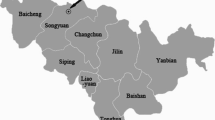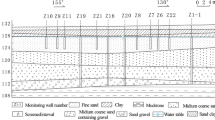Abstract
This study presents a stepwise concept to assess the in situ microbial mineralization of petroleum hydrocarbons (PHC) in aquifers. A new graphical method based on stable carbon isotope ratios (δ13C) was developed to verify the origin of dissolved inorganic carbon (DIC). The concept and the isotope method were applied to an aquifer in Studen, Switzerland, in which more than 34,000 liters of heating oil were accidentally released. Chemical analyses of ground water revealed that in this aquifer locally, anaerobic conditions prevailed, and that PHC mineralization was linked to the consumption of oxidants such as O2, NO -2 , and SO 2-4 and the production of reduced species such as Fe2+, Mn2+, HSS and CH4. However, alkalinity and DIC balances showed a quantitative disagreement in the link between oxidant consumption and DIC production, indicating that chemical data alone may not be a reliable assessment tool. δ13C ratios in DIC have been used before for bioremediation assessment, but results were reported to be negatively influenced by methanogenesis. Using the new graphical method to display δ13C data, it was possible to identify anomalies found in methanogenic monitoring wells. It could be shown that 88% of the DIC produced in the contaminated aquifer originated from microbial PHC mineralization. Thus, the new graphical method to display δ13C ratios appears to be a useful tool for the assessment of microbial hydrocarbon mineralization in a complex environment.
Similar content being viewed by others
References
Aggarwal PK, Fuller ME, Gurgas MM, Manning JF & Dillon MA (1997) Use of stable oxygen and carbon isotope analyses for monitoring the pathways and rates of intrinsic and enhanced in situ biodegradation. Environmental Science and Technology 31: 590–596
APHA (1989) Standard methods for the examination of water and wastewater. American Public Health Association, Clesceri LS, Greenberg AE & Trussell RR (Eds), Washington DC
ASTM (1995) Standard guide for risk-based corrective action applied at petroleum release sites. American Society for Testing and Materials, West Conshohocken
Atlas RM & Bartha R (1992) Hydrocarbon biodegradation and oil spill bioremediation. Advances in Microbiological Ecology 12: 287–338
Baedecker MJ, Cozzarelli IM, Eganhouse RP, Siegel DI & Bennett PC (1993) Crude oil in a shallow sand and gravel aquifer — III Biogeochemical reactions and mass balance modeling in anoxic groundwater. Applied Geochemistry 8: 569–586
Bedient PH, Rifai HS & Newell CJ (1994) Ground water contamination: transport and remediation. Prentice Hall, Englewood Cliffs, NJ
Bennett PC, Siegel DE, Baedecker MJ & Hult MF (1993) Crude oil in a shallow gravel aquifer — I. Hydrogeology and inorganic geochemistry. Applied Geochemistry 8: 529–549
Biaggi D, Bossart P, Kuhlmann U & Muchenberger F (1994) Modellierung der Strömung und der Nitratausbreitung im Berner Seeland, Schweiz. Eclogae Geologicac Helvetiae 87: 429–438
Borden RC, Gomez CA & Becker MT (1995) Geochemical indicators of intrinsic bioremediation. Ground Water 33:180–189
Bossard P, Joller T & Szabo E (1981) Die quantitative Erfassung von Methan im Seewasser. Schweizerische Zeitschrift für Hydrologie 43: 200–211
Boulding JR (1995) Practical handbook of soil, vadose zone, and ground-water contamination: Assessment, prevention, and remediation. Lewis Publishers, Boca Raton
Boutton TW (1991) Stable carbon isotope ratios of natural materials: II. Atmospheric, terrestrial, marine, and freshwater environments. In: Coleman DC & Fry B (Eds) Carbon isotope techniques (pp 173–185). Academic Press, San Diego
Carothers WW, Adami LH & Rosenbauer RJ (1988) Experimental oxygen isotope fractionation between siderite-water and phosphoric acid liberated CO2-siderite. Geochimica et Cosmochimica Acta 52: 2445–2450
Carothers WW & Kharaka K (1980) Stable carbon isotopes of HCO −3 in oil-field waters — implications for the origin of CO2. Geochimica et Cosmochimica Acta 44: 323–332
Conrad ME, Daley PF, Fischer ML, Buchanan BB, Leighton T & Kashgarian M (1997) Combined 14C and δ 13C monitoring of in situ biodegradation of petroleum hydrocarbons. Environmental Science and Technology 31: 1463–1469
Coplen TB (1996) New guideline for reporting stable hydrogen, carbon, and oxygen isotope-ratio data. Geochimica et Cosmochimica Acta 60: 3359–3360
Davis JW, Klier NJ & Carpenter CL (1994) Natural biological attenuation of benzene in ground water beneath a manufacturing facility. Ground Water 32: 215–226
Davis SN, Thompson GM, Bemtley HW & Stiles G (1980) Ground water tracers — a short review. Ground Water 18: 14–23
Deines P & Langmuir D (1974) Stable carbon isotope ratios and the existence of a gas phase in the evolution of carbonate ground water. Geochimica et Cosmochimica Acta 38: 1147–1164
Eganhouse RP, Baedecker MJ, Cozzarelli IM, Aiken GR, Thorn KA & Dorsey TF (1993) Crude oil in a shallow sand and gravel aquifer — II Organic geochemistry. Applied Geochemistry 8: 551–567
Eaganhouse RP, Dorsey TF, Phinney CS & Westcott AM (1996) Processes affecting the fate of monoaromatic hydrocarbons in an aquifer contaminated by crude oil. Environmental Science and Technology 30: 3304–3312
Fresenius W, Quentin KE & Schneider W (1988) Water analysis. Springer, New York
Fritz SJ (1994) A survey of charge-balance errors on published analyses of potable ground and surface waters. Ground Water 32: 539–546
Gelhar LW, Welty C & Rehfeldt KR (1992) A critical review of data on field-scale dispersion in aquifers. Water Resources Research 28: 1955–1974
Grossman, EL (1997) Stable carbon isotopes as indicators of microbial activity in aquifers. In: Hurst CJ (Ed) Manual of environmental microbiology, (pp 565–576), American Society for Microbiology, Washington DC
Herczeg AL, Torgersen T, Chivas AR & Habermehl MA (1991) Geochemistry of ground waters from the Great Artesian Basin. Australia Journal of Hydrology 126: 225–246
Hess A, Höhener P, Hunkeler D & Zeyer J (1996) Bioremediation of a diesel fuel contaminated aquifer: Simulation studies in laboratory aquifer columns. Journal of Contaminant Hydrology 23: 329–345
Holliger C & Zehnder AJB (1996) Anaerobic biodegradation of hydrocarbons. Current Opinion in Biotechnology 7: 326–330
Hunkeler D (1997) Assessment and quantification of bioremediation in anaerobic aquifers. Ph.D. Thesis Nr. 12268 ETH Zürich
Hunkeler D, Höhener, P, Bernasconi S & Zeyer J (1999) Engineered in situ bioremediation of a petroleum hydrocarbon-contaminated aquifer: Assessment of mineralization based on alkalinity, inorganic carbon and stable carbon isotope balances. Journal of Contaminant Hydrology: 37: 201–223
Hunkeler D, Jörger D, Haberli K, Höhener P & Zeyer J (1998) Petroleum hydrocarbon mineralization in anaerobic laboratory aquifer columns. Journal of Contaminant Hydrology 32: 41–61
Jussel P, Stauffer F & Dracos T (1994) Transport modeling in heterogeneous aquifers 1. Statistical description and numerical generation of gravel deposits. Water Resources Research 30: 1803–1817
Kozel R (1992) The detection of organic pollutants, i.e. pesticides, in near-surface porous aquifers (in German). Ph.D. Thesis, University of Neuchâtel, Switzerland
Krumholz LR, Caldwell ME & Suflita JM (1996) Biodegradation of BTEX hydrocarbon compounds under anaerobic conditions. In: Crawford RL & Crawford DL (Ed) Bioremediation Principles and Applications (pp 61–99). Cambridge University Press, Cambridge
Landmeyer JE, Vroblesky DA & Chapelle FH (1996) Stable carbon isotope evidence of biodegradation zonation in a shallow jet-fuel contaminated aquifer. Environmental Science and Technology 30: 1120–1128
LeBlanc DR, Garabedian SP, Hess KM, Gelhar LW, Quadri RD, Stollenwerk KG & Wood WW (1991) Large-scale natural gradient tracer test in sand and gravel, Cape Cod, Massachusetts 1. Experimental design and observed tracer movement. Water Resources Research 27: 895–910
MacDonald JA & Rittmann BE (1993) Performance standards for in situ bioremediation. Environmental Science and Technology 27: 1974–1979
Madsen EL, Sinclair JL & Ghiorse WC (1991) In situ biodegradation: Microbiological patterns in a contaminated aquifer. Science 252: 830–833
Martin-Hayden JM & Robbins GA (1997) Plume distortion and apparent attenuation due to concentration averaging in monitoring wells. Ground Water 35: 339–346
Matthess G & Ubell K (1983) Allgemeine Hydrogeologie — Grundwasserhaushalt. Lehrbuch der Hydrogeologie. Gebrüder Borntraeger, Berlin
McAllister PM & Chiang CY (1994) A practical approach to evaluating natural attenuation of contaminants in ground water. Ground Water Monitoring and Remediation 14: 161–173
Merkt C & Stebler T (1998) Grundwassermodell für die Sanierung eines heizölkontaminierten Grundwasserleiters in der Gemeinde Studen (BE). Diplomathesis, Institute of Terrestrial Ecology ETH Zürich
Revesz K, Coplen TB, Baedecker MJ & Glynn PD (1995) Methane production and consumption monitored by stable H and C isotope ratios at a crude oil spill site, Bemidji, Minnesota. Applied Geochemistry 10: 505–516
Rifai HS, Borden RC, Wilson JT & Ward CH (1995) Intrinsic bioattenuation for subsurface restoration. In: Hinchee RE, Wilson JT & Downey DC (Eds) Intrinsic bioremediation, Vol 1 (pp 1–31). Battelle Press, Columbus
Schwarzenbach RP, Gschwend PM & Imboden DM (1993) Environmental organic chemistry. John Wiley & Sons, New York
Stumm W & Morgan JJ (1996) Aquatic chemistry, 3rd ed. John Wiley and Sons, New York
U.S. National Research Council (1993) In situ bioremediation — when does it work? National Academy Press, Washington DC
Van de Velde KD, Marley MC, Studer J & Wagner DM (1995) Stable carbon isotope analysis to verify bioremediation and bioattenuation. In: Hinchee RE, Douglas GS & Ong SK (Eds) Monitoring and verification of bioremediation, Vol 5 (pp 241–257). Battelie Press, Columbus, Ohio
Vroblesky DA & Chapelle FH (1994) Temporal and spatial changes of terminal electron-accepting processes in a petroleum hydrocarbon-contaminated aquifer and the significance for contaminant biodegradation. Water Resources Research 30: 1561–1570
Weiss RF & Price BA (1980) Nitrous oxide solubility in water and seawater. Marine Chemistry 8: 347–359
Yamamoto S, Alcauskas JB & Crozier TE (1976) Solubility of methane in distilled water and seawater. Journal of Chemical and Engineering Data 21: 78–80
Author information
Authors and Affiliations
Rights and permissions
About this article
Cite this article
Bolliger, C., Höhener, P., Hunkeler, D. et al. Intrinsic bioremediation of a petroleum hydrocarbon-contaminated aquifer and assessment of mineralization based on stable carbon isotopes. Biodegradation 10, 201–217 (1999). https://doi.org/10.1023/A:1008375213687
Issue Date:
DOI: https://doi.org/10.1023/A:1008375213687




